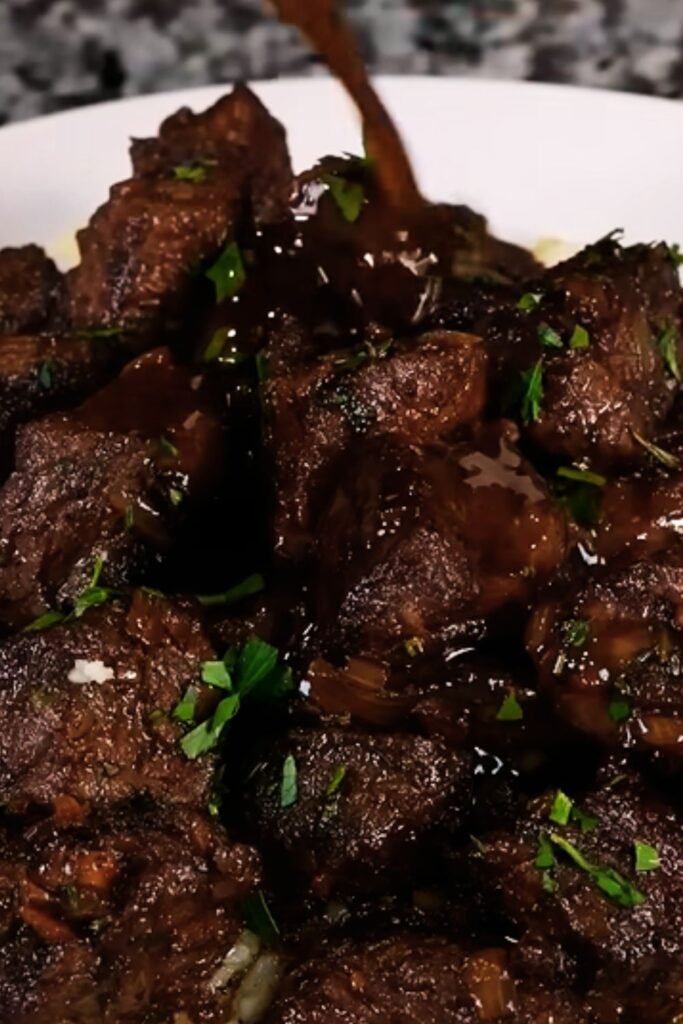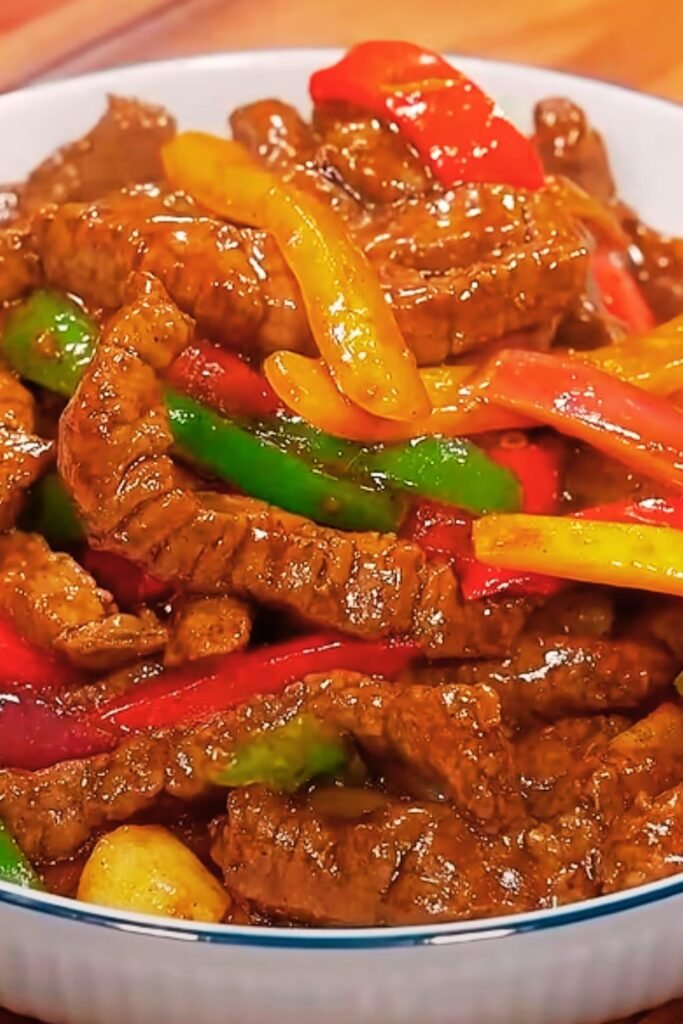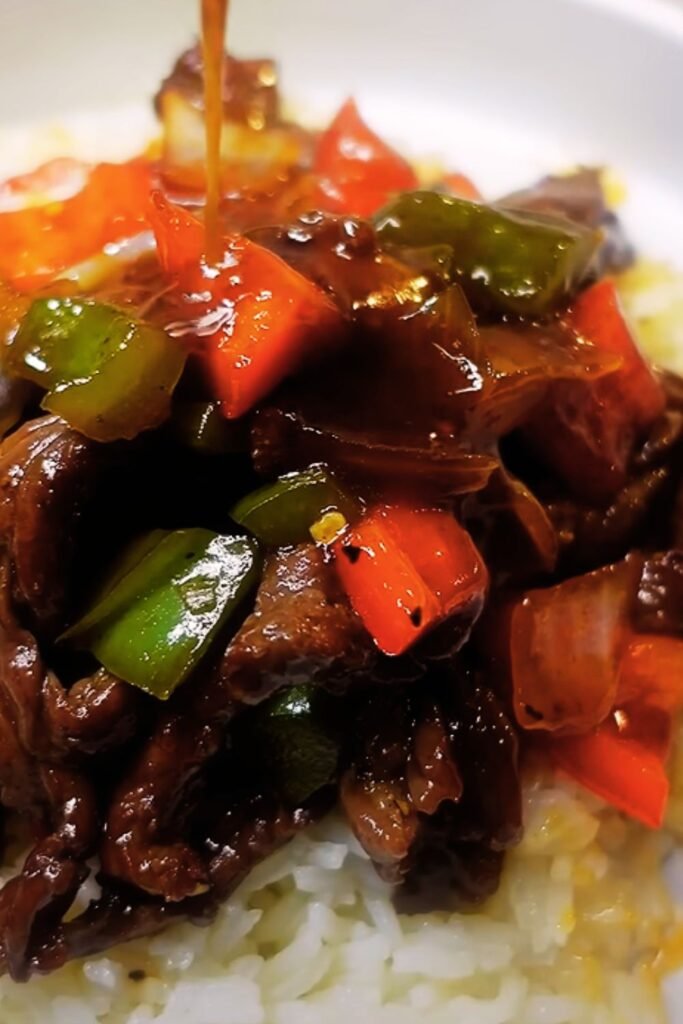There’s something deeply satisfying about the sizzle of beef hitting a hot wok and the aromatic blend of garlic, ginger, and soy sauce filling your kitchen. That’s why pepper steak with onion stir fry has been my go-to weeknight dinner for years. This classic dish combines tender strips of beef with colorful bell peppers and sweet onions in a savory sauce that’s simply irresistible.
I’ve perfected this recipe through countless iterations in my home kitchen, tweaking the marinade, adjusting cooking times, and balancing flavors until it rivals any restaurant version. The beauty of this dish lies in its simplicity—it’s quick enough for busy weeknights yet impressive enough for weekend entertaining.
In this comprehensive guide, I’ll walk you through every step of creating this delicious stir fry, from selecting the right cut of beef to achieving that perfect balance of tenderness and flavor. You’ll learn my secret techniques for velveting beef (a Chinese cooking method that ensures ultra-tender meat) and how to create a sauce that’s both rich and beautifully balanced.
What Makes a Great Pepper Steak Stir Fry?
Before diving into the recipe, let’s understand what makes this dish special:
Bold Flavors: The combination of black pepper, garlic, ginger, and soy sauce creates a deeply savory profile that complements the natural sweetness of bell peppers and onions.
Textural Contrast: Tender beef paired with slightly crisp vegetables offers a satisfying mouthfeel in every bite.
Quick Cooking: The high-heat stir-fry method preserves the vibrant colors and nutrients of the vegetables while quickly cooking the thin slices of beef.
Versatility: This dish pairs beautifully with rice, noodles, or can be enjoyed on its own for a lower-carb option.
Ingredients Breakdown
Let’s take a closer look at each component:
For the Beef and Marinade
- 1½ pounds flank steak or sirloin: I prefer flank steak for its rich flavor and ability to stay tender when cooked quickly. Sirloin is an excellent alternative that’s often more readily available.
- 3 tablespoons soy sauce: Provides the umami foundation for our marinade. I recommend using low-sodium soy sauce to keep the salt levels balanced.
- 1 tablespoon Shaoxing wine (or dry sherry): This traditional Chinese cooking wine adds depth and complexity. Don’t skip this—it’s key for authentic flavor.
- 2 teaspoons cornstarch: This helps create that signature velvety texture by protecting the meat during cooking.
- 1 teaspoon baking soda: My secret weapon for tenderizing tougher cuts of beef. The alkaline nature of baking soda helps break down protein structures.
- 1 tablespoon freshly ground black pepper: Fresh is definitely best here—pre-ground pepper can’t match the aromatic intensity.
For the Stir Fry
- 3 bell peppers (mixed colors): I use a combination of red, green, and yellow for visual appeal and subtle flavor differences.
- 2 medium onions: Yellow onions work best as they become sweeter when cooked.
- 4 cloves garlic, minced: Fresh garlic provides a punchy aromatic base.
- 1 tablespoon fresh ginger, minced: Adds a spicy warmth that’s essential in stir fries.
- 2 tablespoons vegetable oil: Choose a neutral oil with a high smoke point like canola or peanut.
For the Sauce
- ½ cup beef broth: Provides rich flavor and moisture to the dish.
- ¼ cup oyster sauce: This thick, savory sauce adds complexity and a subtle sweetness.
- 2 tablespoons soy sauce: Reinforces the umami notes.
- 1 tablespoon cornstarch: Helps thicken the sauce to the perfect consistency.
- 1 teaspoon sesame oil: A little goes a long way—this adds a nutty fragrance.
- 1 teaspoon sugar: Balances the savory elements and helps with caramelization.
Equipment You’ll Need

- Wok or large skillet: A wok is ideal for its high sides and heat distribution, but a large skillet works well too.
- Sharp knife: For slicing the beef thinly against the grain.
- Cutting board: Preferably one dedicated to meat and another for vegetables.
- Small bowls: For organizing your pre-measured ingredients.
- Wooden spoon or wok spatula: For stirring and tossing ingredients.
Preparation: The Key to Success
Stir-frying happens quickly, so proper preparation is crucial. Here’s my step-by-step approach:
Step 1: Prep the Beef
- Place your beef in the freezer for 15-20 minutes before slicing. This firms it up slightly, making it easier to cut thin, even slices.
- Slice the beef against the grain into thin strips about ¼-inch thick. Cutting against the grain shortens the muscle fibers, resulting in more tender meat.
- In a bowl, combine soy sauce, Shaoxing wine, cornstarch, baking soda, and black pepper.
- Add the beef strips to the marinade, tossing to coat thoroughly. Let it marinate for at least 20 minutes, or up to 4 hours in the refrigerator.
Step 2: Prepare the Vegetables
- Core and seed the bell peppers, then slice into thin strips about ¼-inch wide.
- Peel the onions and slice into thin half-moons.
- Mince the garlic and ginger.
Step 3: Make the Sauce
- In a small bowl, whisk together beef broth, oyster sauce, soy sauce, cornstarch, sesame oil, and sugar until smooth.
- Set aside near your cooking area.
The Cooking Process
Now that everything is prepped, let’s start cooking:
Step 1: Sear the Beef
- Heat your wok or skillet over high heat until it’s smoking hot. This is crucial—a properly heated wok prevents sticking and creates that desirable sear.
- Add 1 tablespoon of oil, swirling to coat the cooking surface.
- Working in batches to avoid overcrowding (which would steam rather than sear the meat), add beef strips in a single layer.
- Cook undisturbed for 30-45 seconds until the bottom is browned, then stir and cook for another 30 seconds.
- Remove beef to a clean plate and repeat with remaining beef if necessary.
Step 2: Stir Fry the Aromatics and Vegetables
- Add the remaining tablespoon of oil to the same wok.
- Add minced garlic and ginger, stir-frying for about 15 seconds until fragrant.
- Add the sliced onions and stir-fry for 1-2 minutes until they start to soften.
- Add the bell peppers and stir-fry for 2-3 minutes until they’re crisp-tender. I like my peppers to retain some crunch—they should be bright and vibrantly colored.
Step 3: Combine and Finish
- Return the beef and any accumulated juices to the wok.
- Give your sauce mixture a quick stir (the cornstarch may have settled), then pour it into the wok.
- Stir continuously as the sauce begins to bubble and thicken, about 1-2 minutes.
- Once the sauce coats the ingredients with a glossy sheen, remove from heat.
Serving Suggestions

Pepper steak stir fry is incredibly versatile when it comes to serving options:
- Steamed Rice: The classic pairing. I prefer jasmine rice for its fragrance, but any long-grain rice works well.
- Noodles: Try it over cooked lo mein noodles or rice noodles for a different texture.
- Cauliflower Rice: For a lower-carb alternative that still soaks up all the delicious sauce.
- Fresh Garnishes: Sliced green onions, cilantro leaves, or sesame seeds add color and flavor.
- Side Dishes: A simple cucumber salad or steamed broccoli makes a refreshing accompaniment.
Comprehensive Recipe Table
| Component | Ingredients | Quantity | Preparation Method |
|---|---|---|---|
| Beef & Marinade | Flank steak or sirloin | 1½ pounds | Thinly sliced against the grain |
| Soy sauce | 3 tablespoons | Low-sodium preferred | |
| Shaoxing wine (or dry sherry) | 1 tablespoon | Room temperature | |
| Cornstarch | 2 teaspoons | Mixed with liquids | |
| Baking soda | 1 teaspoon | Dissolve completely | |
| Black pepper | 1 tablespoon | Freshly ground | |
| Vegetables | Bell peppers (mixed colors) | 3 medium | Sliced into ¼-inch strips |
| Onions | 2 medium | Sliced into thin half-moons | |
| Garlic | 4 cloves | Minced | |
| Ginger | 1 tablespoon | Fresh, minced | |
| Sauce | Beef broth | ½ cup | Room temperature |
| Oyster sauce | ¼ cup | Shake before measuring | |
| Soy sauce | 2 tablespoons | Low-sodium preferred | |
| Cornstarch | 1 tablespoon | Dissolved in the liquids | |
| Sesame oil | 1 teaspoon | Added last | |
| Sugar | 1 teaspoon | Granulated | |
| Cooking | Vegetable oil | 2 tablespoons | Divided for beef and vegetables |
Nutritional Information
| Nutrient | Amount per Serving |
|---|---|
| Calories | 325 |
| Protein | 32g |
| Carbohydrates | 15g |
| Fiber | 3g |
| Sugar | 8g |
| Fat | 16g |
| Saturated Fat | 4g |
| Cholesterol | 75mg |
| Sodium | 920mg |
| Potassium | 620mg |
| Iron | 3.5mg |
| Vitamin C | 145mg |
Nutritional information based on 4 servings without rice or noodles
Troubleshooting Common Issues
Even experienced cooks encounter challenges. Here are solutions to common pepper steak problems:
Tough Beef
Problem: The beef turns out chewy rather than tender.
Solutions:
- Ensure you’re slicing against the grain
- Don’t skip the marinade with baking soda
- Avoid overcooking—beef only needs 1-2 minutes total cooking time
- Consider using a different cut like ribeye if you consistently have issues
Watery Sauce
Problem: The sauce is too thin and doesn’t coat the ingredients well.
Solutions:
- Make sure your cornstarch is fully dissolved before adding to the wok
- Let the sauce come to a full bubble before removing from heat
- If needed, mix 1 teaspoon cornstarch with 1 tablespoon cold water and stir into the simmering sauce
Soggy Vegetables
Problem: Peppers and onions are limp instead of crisp-tender.
Solutions:
- Use high heat throughout the cooking process
- Don’t overcrowd the wok—cook in batches if necessary
- Stir-fry vegetables for less time if they’re consistently overcooked
Variations to Try

Once you’ve mastered the basic recipe, consider these delicious variations:
Spicy Pepper Steak
Add 1-2 thinly sliced jalapeños or 1 teaspoon of crushed red pepper flakes when stir-frying the aromatics.
Mushroom Pepper Steak
Add 8 ounces of sliced mushrooms (shiitake or cremini work well) when stir-frying the onions.
Pineapple Pepper Steak
Add 1 cup of fresh pineapple chunks during the last minute of cooking for a sweet-savory twist.
Beef and Broccoli Fusion
Replace half the bell peppers with 2 cups of small broccoli florets (blanch them for 1 minute before adding).
Make-Ahead and Storage Tips
Make-Ahead: You can prep all components 1-2 days in advance:
- Slice beef and store in marinade (refrigerated)
- Cut vegetables and store in airtight containers
- Mix sauce ingredients and refrigerate
Storage: Leftover pepper steak will keep in an airtight container in the refrigerator for 3-4 days.
Reheating: For best results, reheat in a skillet over medium heat just until warmed through. Microwave reheating works in a pinch but may make the beef tougher.
Freezing: While possible, I don’t recommend freezing this dish as the vegetables will lose their texture. If you must freeze, use within 2 months and thaw in the refrigerator overnight before gently reheating.
Q&A Section
Q: Can I use pre-cut beef strips from the grocery store?
A: Yes, but they’re often cut with (not against) the grain for stewing, not stir-frying. If using pre-cut strips, pound them gently with a meat mallet before marinating to help tenderize them.
Q: I don’t have oyster sauce. What can I substitute?
A: Fish sauce mixed with a bit of brown sugar works well. For a vegetarian option, try hoisin sauce thinned with a little water, or mushroom-flavored soy sauce.
Q: How do I make this dish gluten-free?
A: Use tamari instead of soy sauce, and ensure your oyster sauce is gluten-free (some brands contain wheat). Also check that your beef broth doesn’t contain gluten ingredients.
Q: Can I use frozen peppers and onions?
A: While fresh is always best for texture and flavor, frozen vegetables will work in a pinch. Thaw and drain them thoroughly before cooking, and reduce the stir-fry time to prevent them from becoming mushy.
Q: How can I make this dish lower in sodium?
A: Use low-sodium soy sauce, low-sodium beef broth, and reduce the oyster sauce by half. You can add more freshly ground pepper and a dash of balsamic vinegar to maintain flavor complexity.
Q: Is there a vegetarian version of this dish?
A: Absolutely! Replace the beef with extra-firm tofu (pressed and cut into cubes) or use seitan strips. Marinate them similarly but omit the baking soda. Use vegetable broth instead of beef broth and mushroom oyster sauce instead of regular oyster sauce.
The Science Behind Great Stir Fry
Understanding a few key scientific principles can elevate your stir-fry game:
Maillard Reaction: This chemical reaction between amino acids and reducing sugars creates the complex flavors and appealing brown color when meat is seared at high temperatures. To maximize this effect, ensure your wok is properly preheated and pat your beef dry before adding it.
Velveting: This technique uses cornstarch and alkaline ingredients (like baking soda) to create a protective coating around meat proteins, preventing them from tightening too much during cooking. The result is extraordinarily tender meat, even with quick-cooking methods.
Carryover Cooking: Food continues to cook from residual heat after being removed from the heat source. For stir-fries, this means you should remove ingredients slightly before they reach your desired doneness.
Why This Recipe Works
After years of refinement, I’ve discovered several key factors that make this pepper steak recipe foolproof:
- The Marinade Combination: The blend of soy sauce, wine, cornstarch, and baking soda doesn’t just flavor the beef—it fundamentally changes its texture, ensuring tender results.
- Cooking in Batches: This prevents overcrowding, which would cause steaming rather than searing.
- Temperature Management: Maintaining high heat throughout creates the proper sear and preserves the vegetables’ texture.
- Sauce Consistency: The ratio of liquids to cornstarch creates a sauce that’s thick enough to coat ingredients without becoming gloopy.
- Timing: Adding components in the right order ensures everything is perfectly cooked without anything being overdone.
Final Thoughts
Pepper steak with onion stir fry exemplifies how a few simple ingredients, properly prepared, can create a dish that’s far greater than the sum of its parts. The combination of tender beef, crisp-tender vegetables, and savory sauce delivers a satisfying meal that’s both comforting and exciting.
What I love most about this dish is its adaptability—it’s equally at home as a quick Tuesday night dinner or the centerpiece of a weekend gathering. The techniques you’ll learn making this recipe (proper marinating, high-heat searing, sauce thickening) will serve you well across many Asian-inspired dishes.
I encourage you to make this recipe your own. Once you’ve mastered the basic version, experiment with different vegetables, adjust the seasonings to suit your taste, or try one of the variations suggested above. The possibilities are endless, and the results are consistently delicious.
Happy cooking!
Q&A Section
Q: What’s the best cut of beef for pepper steak?
A: Flank steak is my top choice for its rich flavor and how well it responds to the marinade. Sirloin is an excellent alternative, while ribeye offers the most tenderness but at a higher price point. Avoid cuts like chuck or round steak, which can remain tough even with proper technique.
Q: Can I make this dish ahead for a party?
A: Yes, but with some adjustments. I recommend preparing all components separately: marinate and cook the beef, slice the vegetables, and prepare the sauce. Store them separately, then quickly stir-fry everything together just before serving. This preserves the ideal texture of each component.
Q: How spicy is this dish?
A: As written, this recipe has a mild peppery kick but isn’t truly spicy. The black pepper provides more flavor than heat. If you prefer more heat, add sliced fresh chilis or crushed red pepper flakes to taste.
Q: Can I use a regular skillet instead of a wok?
A: Absolutely! A large cast iron or stainless steel skillet works well. The key is using high heat and not overcrowding the pan. You might need to cook in more batches than you would with a wok’s larger surface area.
Q: What’s the secret to restaurant-quality stir fry at home?
A: Besides proper technique, restaurants often use much higher heat than most home stoves can produce. To compensate, cook in smaller batches, preheat your pan thoroughly, and keep ingredients moving constantly. Also, don’t be afraid to use enough oil—it helps conduct heat and create that glossy restaurant finish.